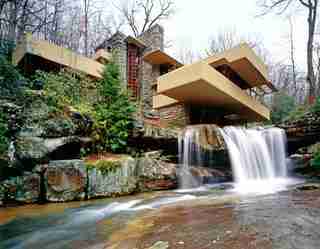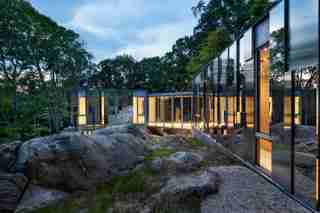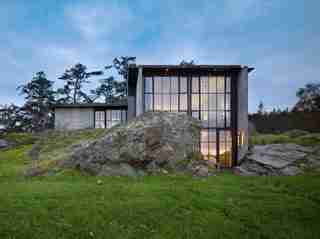January 17,2023
Amazing Architecture on the Rocks
by David Stewart

Frank Lloyd Wright understood that juxtaposing rugged natural features with bold modern forms could highlight the qualities of both. At Fallingwater he used the strategy to great effect, creating a masterpiece of American architecture. Completed in 1938, the house features contrasting horizontal planes in stucco anchored by vertical planes of stacked fieldstone. This complex composition perches above a rushing waterfall cascading over massive boulders. Since the completion of Fallingwater, modern architects from Scandinavia to the Mediterranean have been using dramatic landscape features to create place-specific buildings that are rooted in their contexts. Today, a new generation of architects is using contrasting materials, reflectivity, and structural ingenuity to create buildings that straddle, nestle on, or slice into the geography and geology of their sites.

A rocky escarpment in Pound Ridge, New York, provides both a setting and a foil for this floating, mirrored house by KieranTimberlake. Resting on piers of geometrically stacked fieldstone, the house’s façade of glass, matte steel, and polished steel creates a shimmering surface that changes throughout the day and the seasons.

Olson Kundig, among the most respected architecture firms of the Pacific Northwest, cut into a stone outcropping to create a house called the Pierre, the French word for “stone.” Rectilinear concrete walls hold their own against the organic forms of the boulders. A green roof helps the house blend into the landscape.
New York– and Oslo-based firm Snøhetta sliced through solid rock to create the space for the Norway’s Petter Dass Museum, which commemorates the life of the Norwegian clergyman and poet. The smooth cut-rock walls provide a counterpoint to the contemporary architecture with a cantilevered second floor over the entrance. The incision in the landscape allows the building to slot into the historically significant site rather than dominating it.
A footbridge and viewing platform in a forested region of Norway straddles two stone outcroppings. A footbridge and viewing platform designed by Rintala Eggertsson Architects straddles two stone outcroppings in a forested region of Norway. Two Corten steel lattice beams link the north and south banks of the Suldal River. A concrete viewing platform offers a spot for picnics that emphasizes the dramatic topography and scenic grandeur of the site.
On the cliffs of Ayora, Spain, Fran Silvestre Arquitectos has designed the stark white House on the Castle Mountainside. The walls are slightly angled and punctured by vast openings, creating a bold geometry out of subtly shifted planes. The austerity of the house is heightened by its rugged surroundings.
Conceived almost at the same time as Wright’s creation, Casa Malaparte was designed for the writer and diplomat Curzio Malaparte by Italian architect Adalberto Libera. Set on a rocky outcropping on the island of Capri, the red stucco house is topped by a pyramidal staircase leading to a rooftop terrace with panoramic views of the Gulf of Salerno. The house played a starring role in Jean-Luc Godard’s film Contempt.
This Norweigan hunting lodge, also by Snøhetta, disappears into the landscape from certain vantage points. Covered in stones and planted with grasses and mosses, the tiny rustic retreat can sleep up to 21 people on a series of built-in beds that double as seating and dining areas.
Designed by architect Kendrick Bangs Kellogg, this house in Joshua Tree, California, is both otherworldly and of the land. The fluid rooflines recall petals or other plantlike forms, but the solid, stone-color concrete helps root the home to its desert location. Designer John Vugrin recently updated the interior, which includes several preserved boulders.
Kengo Kuma, one of Japan’s most innovative architects, has playfully inverted the idea of architecture in landscape by inventing a topography for the Lotte Jeju Resort on South Korea’s Jeju Island. Moundlike roofs are studded with rocks, concealing soaring, light-filled interiors with crisscrossed lattice ceilings.






